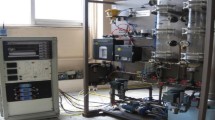Abstract
Introduction
Co-simulation is a technique to overcome difficulties related to the simulation of a system running in multiple environments. It is accomplished performing the global simulation by composing different simulation machines.
Purpose
In this work, the development of a co-simulation system for a multivariable Tthree-Ttank liquid level system is presented.
Method
The simulation of the Three-Tank liquid level system runs part in a digital computer, in the LabViewTM system, and part in an analogue computer in order to feature both discrete and analogue models connected by a data communication system. The robust controller designed with the LQG/LTR technique is implemented using SciLabTM application. Additionally, an alternative setup is considered, implementing the previous analogue computer in a circuit simulator, the Electronics Workbench EWBTM. The data communication between the plant and the controller (process variables and control signals) is developed using the Open Platform Communications (OPC) industrial communications protocol.
Conclusion
The proposed co-simulation technique is suitable to integrate different simulation software and machines with pre-existent facilities or structures and new developments, even if remotely located, and allowing to assess the performance of control systems, sensors, actuators, and embedded software and hardware.



















Similar content being viewed by others
References
Athans M (1986) A tutorial on the LQG/LTR method. In: 1986 American control conference, pp 1289–1296 . https://doi.org/10.23919/ACC.1986.4789131
Bueno AM, Leite Filho WC (2003) Parameter identification of actuator nonlinear model based on limit-cycle phenomenon. In: Anais do XVII Congresso Brasileiro de Engenharia Mecanica, vol AE04. São Paulo, Brasil
Carrijo D, Oliva A, Filho WCL (2002) Hardware-in-loop simulation development. Int J Model Simul 22(3):167–175. https://doi.org/10.1080/02286203.2002.11442238
Chiodo M, Giusto P, Jurecska A, Hsieh HC, Sangiovanni-Vincentelli A, Lavagno L (1994) Hardware-software codesign of embedded systems. IEEE Micro 14(4):26–36. https://doi.org/10.1109/40.296155
Dermendjian FH, Bueno AM, Machado RG, Serni PJA, Balthazar, JM (2019) On vibration engineering and technology of machinery Vectomac XV, LQG/LTR control of a three tank level system
Desai R, Guha A, Seshu P (2021) A comparison of quarter, half and full car models for predicting vibration attenuation of an occupant in a vehicle. J Vib Eng Technol 9(5):983–1001. https://doi.org/10.1007/s42417-020-00278-3.
Fitzgerald J, Pierce K (2014) Co-modelling and co-simulation in embedded systems design. Springer, Berlin, pp 15–25
Halliday D, Resnick R, Walker J (2013) Fundamentals of physics. Wiley, Hoboken
Khaitan SK, McCalley JD (2015) Design techniques and applications of cyberphysical systems: a survey. IEEE Syst J 9(2):350–365. https://doi.org/10.1109/JSYST.2014.2322503
Klee H, Allen R (2011) Simulation of dynamic systems with Matlab and Simulink, 2nd edn. CRC Press, Boca Raton
Lieping Z, Maoyao A, Yunsheng Z (2007) On remote monitor and control based on OPC and ASP.net. pp 384–387. https://doi.org/10.1109/CHICC.2006.4347273
Martinov G, Issa A, Martinova L (2019) Controlling can servo step drives and their remote monitoring by using protocol OPC UA. pp 1–5. https://doi.org/10.1109/FarEastCon.2019.8934338
de Moraes AT, Kienitz K (2017) Robust control of an industrial pilot plant. IEEE Latin Am Trans 15(9):1613–1620. https://doi.org/10.1109/TLA.2017.8015043
das Neves GP, Barbosa FS, Costa PS, Angélico BA (2016) Discrete time LQG/LTR applied to a practical quadruple tank system. pp 1232–1237. https://doi.org/10.1109/CCA.2016.7587975
Nguyen V, Besanger Y, Tran Q, Nguyen T (2017) On conceptual structuration and coupling methods of co-simulation frameworks in cyber-physical energy system validation. Energies 10(12):1977. https://doi.org/10.3390/en10121977
Sinha A (2007) Linear systems: optimal and robust control. Taylor & Francis Group, New York
Stein G, Athans M (1987) The LQG/LTR procedure for multivariable feedback control design. Autom Control IEEE Trans 32(2):105–114. https://doi.org/10.1109/TAC.1987.1104550
...Steinbrink C, Lehnhoff S, Rohjans S, Strasser TI, Widl E, Moyo C, Lauss G, Lehfuss F, Faschang M, Palensky P, van der Meer AA, Heussen K, Gehrke O, Guillo-Sansano E, Syed MH, Emhemed A, Brandl R, Nguyen VH, Khavari A, Tran QT, Kotsampopoulos P, Hatziargyriou N, Akroud N, Rikos E, Degefa MZ (2017) Simulation-based validation of smart grids—status quo and future research trends. In: Mařík V, Wahlster W, Strasser T, Kadera P (eds) Industrial applications of holonic and multi-agent systems. Springer International Publishing, Cham, pp 171–185
Verhoef M (2009) Modeling and validating distributed embedded real-time control systems. Institute for Programming research and Algorithmics (Ph.D. thesis)
Wei L, Jiang M, Shen Y, Fei M (2010) Real-time remote monitored control systems for teaching based on web. In: 2010 International conference on networking and digital society, vol 1, pp 334–338 (2010). https://doi.org/10.1109/ICNDS.2010.5479198
Yu S, Zhou Y, Feng Y, Qu T, Chen H (2018) Liquid level tracking control of three-tank systems. pp 3541–3545. https://doi.org/10.23919/ChiCC.2018.8482966
Zhao Y, Liu Y, Yang S, Liao Y, Li Y (2021) A new coordination control strategy on secondary lateral damper for high-speed trains. J Vibr Eng Technol. https://doi.org/10.1007/s42417-021-00382-y
Acknowledgements
The authors acknowledge the National Council for Scientific and Technological Development (CNPq) and Coordenação de Aperfeiçoamento de Pessoal de Nível Superior—Brasil (CAPES).
Author information
Authors and Affiliations
Corresponding author
Ethics declarations
Conflict of interest
There is no conflict of interest between the authors.
Additional information
Publisher's Note
Springer Nature remains neutral with regard to jurisdictional claims in published maps and institutional affiliations.
Rights and permissions
About this article
Cite this article
Bueno, Á.M., Serni, P.J.A., Machado, R.G. et al. Robust Control and Co-simulation of a Multivariable Nonlinear Liquid Level Control System. J. Vib. Eng. Technol. 10, 2049–2060 (2022). https://doi.org/10.1007/s42417-022-00444-9
Received:
Revised:
Accepted:
Published:
Issue Date:
DOI: https://doi.org/10.1007/s42417-022-00444-9




